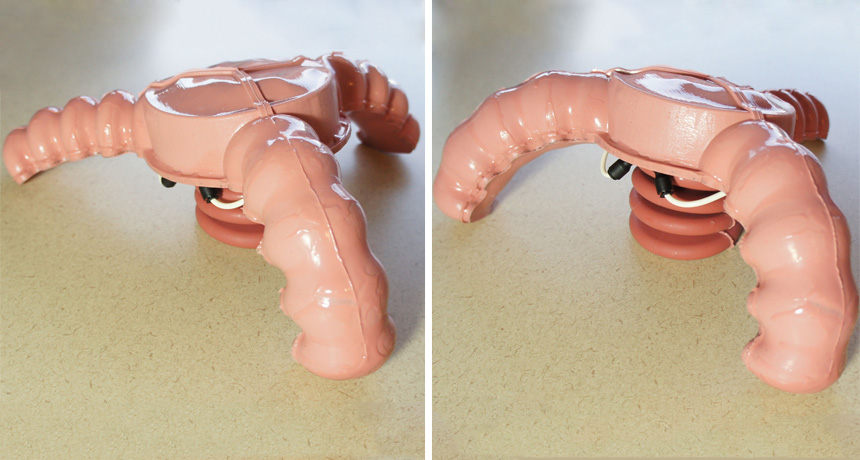Squishy robot propelled by ka-pow!
Small explosions send this soft machine hopping

This squishy, silicone-based robot is powered by explosions. Something like it may prove useful in finding victims in disaster zones.
M. Tolley
Forget about motors, wheels or legs. A new type of robot is propelled by an explosion. Engineers fashioned most of the machine from a strong, squishy material called silicone. A small blast in one of its legs shoots the pie-sized contraption skyward.
The robot has a soft, central body, from which three legs extend outward. Each leg looks “like a Slinky dipped in melted erasers,” explains Science News writer Meghan Rosen. A fourth limb extends downward from the center and looks like a spring.
This new, explosion-driven robot may be useful in disaster zones, Sampriti Bhattacharyya told Science News. She is an engineer at MIT in Cambridge, Mass., and did not work on the project. Rocks and other rubble may block robots that have to roll or walk across the ground. “You want something very fast that can climb over broken stuff,” she said. Soft robots like this also can take a beating without breaking. Plus, their squishy bodies don’t pose a threat to people.
The robot’s creators work at Harvard University in Cambridge, Mass., and Cornell University in Ithaca, N.Y. They introduced their invention on September 15 in Chicago, Ill. It was at a conference for robot researchers.
It’s tough to make soft robots move fast, notes Harvard engineer Michael Tolley. One that he recently built could function after being subjected to fire, snow and being run over by car. But it had a big drawback: It moved at a snail’s pace. Really. It moved as slowly as a snail.
So Tolley and his team decided to give their newest robot the ability to jump. A built-in air compressor inflates the three outer legs. These lift and tilt the body — aiming it in the direction it should jump. Then, a flammable mix of two gases, butane and oxygen, flows into a chamber at the bottom of the downward-facing, center leg. A spark ignites this fuel. The resulting explosion sends the robot into the air.
In just one second, the robot can fly as high as two 2-liter soft-drink bottles stacked atop each other. In testing the robot, Tolley and his team were able to fling it on top of a box and then off the other side.
But obstacles remain. For instance, the robot often lands upside-down.
“We’re working on that,” Tolley says.
Power Words
butane A flammable hydrocarbon gas that is found in petroleum and is used in bottled form as a fuel.
hydrocarbon Any of a range of large molecules created by chemically bound carbon and hydrogen atoms. Crude oil, for example, is a naturally occurring mix of many hydrocarbons
oxygen A gas that makes up about 21 percent of the atmosphere. All animals and many microorganisms need oxygen to fuel their metabolism.
robot A machine that can sense its environment, process information and respond with specific actions. Some robots can act without any human input; others are guided by a human.
silicone Heat-resistant substances that can be used in many different ways, including the rubber-like materials that provide a waterproof seal around windows and in aquariums. Some silicones serve as grease-like lubricants in cars and trucks. Most silicones, a type of molecule known as a polymer, are built around long chains of silicon and oxygen atom







